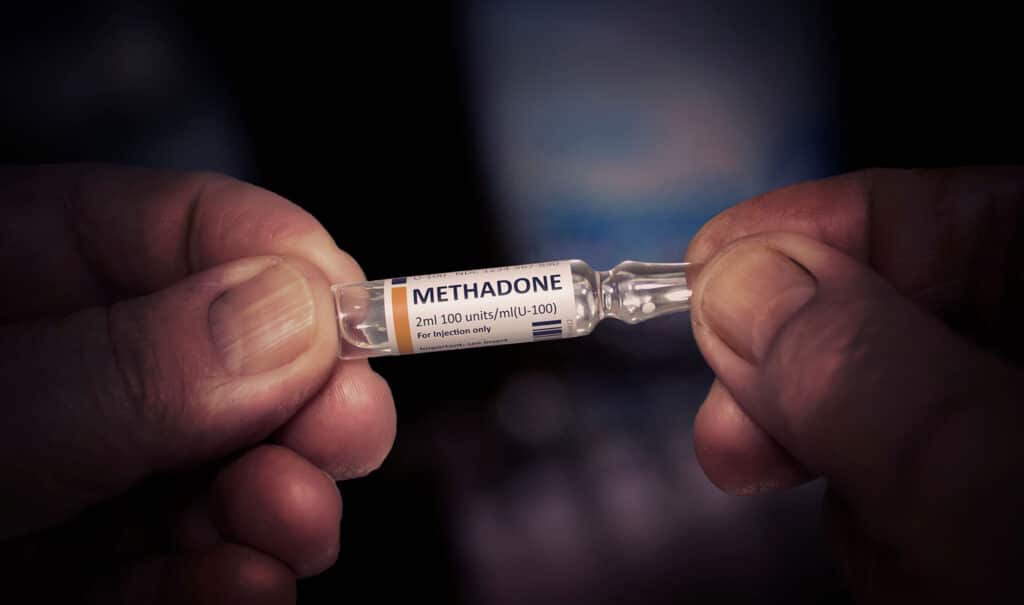Methadone, also known as Methadose and Dolophine, is a medication that targets opioid receptors in the nervous system. It can be used for chronic pain disorder and as a replacement drug to treat addiction.
Although methadone stabilizes patients during their recovery period, it also has a high dependence likelihood. It’s an opioid, and many people can develop an addiction while weaning off another drug.

This article will explain the nature of Methadone, its withdrawal symptoms, and the detox journey. So, let’s dive in.
Table of Contents
Understanding Methadone
Germans developed methadone between 1937 and 1939 to treat severe pain in soldiers who had no access to Morphine. It was used as an analgesic in 1947 in the US.
However, healthcare providers and doctors started using it to treat opioid addictions in the 1960s. It was considered an effective painkiller and a less addictive substitute to other opioids like Heroin.
When people have a problem with abusing opioids like Heroin and OxyContin, Methadone can help control their cravings and ease off the withdrawal symptoms during a medically-assisted detox. However, during this process, they can develop a dependence on Methadone instead.
Some people use Methadone as their drug of choice, but it works differently from opioids. While Heroin and Morphine create euphoric effects, Methadone blocks the pleasure sensations caused by opiates. It can make people sleepy or drowsy and can be used for sedation.
How It Works: Mechanism of Action
As a synthetic and long-lasting opioid, Methadone is a μ-receptor agonist that behaves like endogenous opioids and endorphins to treat pain. It’s also an agonist of κ- and σ-opioid receptors.
When administered, Methadone causes respiratory depression, decreased bowel mobility, sedation, an increase in prolactin and growth hormone release, an increase in bile production, nausea, and hypotension. In this sense, it works like the drugs it’s intended to replace, like Morphine. Nevertheless, its effects are milder and more gradual.
Since this drug has a longer half-life, the drug is slowly absorbed in the body, and the withdrawal symptoms are delayed and less severe compared to other opiates like Heroin. Yet, people who abuse this drug will experience similar symptoms to those they might experience when they stop taking other opioids.
Why Detox from Methadone?
Methadone maintenance treatment, or MMT, is an approved method to manage Heroin addiction. It affects the white and gray matter in the brain and subsequently affects emotional perception and cognitive functions.
Becoming dependent leads to several physical and psychological changes. People start experiencing shallow breathing and fatigue, sexual dysfunction in men and menstrual cycle changes in women, poor judgment that leads to engagement in risky behaviors, and arteriosclerosis.
Short-term side effects of Methadone include urine retention, dry mouth, gastrointestinal distress, seizures, and fainting. It can also lead to hallucinations, insomnia, depression, suicidal thoughts, anxiety, and paranoia.
While weaning off another opioid, the detox process can lower your tolerance. This increases the risk of overdose while taking Methadone, which can sometimes be fatal. A Methadone overdose can cause the following.
- Pinpoint pupils
- Nails and fingertips discoloration with a bluish tint
- Twitching
- Itchy skin
- Drowsiness and dizziness
- Cardiovascular issues like collapsed veins
- Diarrhea
- Hypotension
- Confusion
- Slowed heart beats
- Nausea and vomiting
- Loss of consciousness
- Respiratory depression
- Extreme lethargy
- A comatose state
Distinguishing Between Therapeutic Use and Over-Reliance
It’s crucial to differentiate between using Methadone for its therapeutic benefits while weaning off other opiates and over-reliance. During a medically-assisted detox, Methadone can be an excellent way to manage drug cravings by reducing the severity of withdrawal symptoms.
But, long-term use of Methadone can lead to drug abuse and over-reliance. Patients can no longer function without the drug and become physically and emotionally dependent.
The Potential Health Risks of Long-Term Methadone Use
In addition to the short-term side effects of taking Methadone, patients experience long-term side effects, even if it’s part of a medically-assisted detox. The relief the drug provides leads to physical and psychological dependence.
Physical long-term side effects of Methadone are similar to the ones associated with other opioids like Heroin. It changes the way the neurotransmitters function and can severely damage the kidneys and liver. Psychological long-term side effects include mental illness like depression and paranoia.
Signs and Symptoms of Methadone Withdrawal
Methadone can be an essential drug in treating opioid addiction. However, addiction is common and can lead to severe physical and psychological withdrawal symptoms.
People can experience withdrawal symptoms in the following cases.
- When patients take the wrong dosage, they might experience withdrawal symptoms from the opiate they’re trying to quit.
- Suddenly quitting Methadone as opposed to tapering can lead to severe withdrawal symptoms.
- Some medications can reduce the effects of Methadone, leading to withdrawal symptoms.
- Self-medication can lead to dependence, addiction, and withdrawal if the person decides to stop taking Methadone.
Withdrawal symptoms happen within 30 hours after quitting the drug, and the duration of the symptoms depends on how long you’ve been taking the medication. They can last between three weeks and six months.
Physical Symptoms
The physical withdrawal symptoms of Methadone are similar to the flu. They usually appear 24 to 36 hours after taking the last dose of Methadone and are less severe than the symptoms experienced when you quit other opioids like Heroin.
These symptoms reach their peak three days after quitting the drug. They include the following.
- Chills
- Fatigue and lethargy
- Muscle pain
- Restlessness
- Muscle pain
- Hot flashes
- Excessive sweating
- Diarrhea or constipation
- Loss of appetite
- Teary eyes
- Runny nose
- Yawning
- Sleep problems
Psychological Symptoms
People who use Methadone will experience moderate psychological side effects when they stop taking the drug. The withdrawal symptoms are generally milder when compared to the ones experienced when the patient is weaning off other drugs like Morphine and Heroin. They include the following.
- Mood changes
- Anxiety
- Depression
- Difficulty of concentration
- Irritability
- Confusion
- Sleep problems and nightmares
Withdrawal Phases: Acute vs. Post-Acute Symptoms
Acute withdrawal symptoms happen after the patient immediately quits Methadone. These symptoms are usually related to physical discomfort, lasting for two weeks at most.
Post-acute withdrawal symptoms, or PAWS, are psychological and emotional symptoms that usually start after the previous phase. Drug abuse changes the way the brain functions, and these symptoms result from the chemical changes in the brain. They are part of the adaptation mechanism as the brain tries to recover from drug dependence.
The severity of PAWS depends on the frequency and amount of Methadone taken. So, if you’ve been taking this drug for an extended period, these symptoms will likely last for a long time.
Stressful situations can trigger PAWS, and they worsen if the patient suffers from other physical or mental health issues. They usually affect the patient in episodes that can last for several days at a time. Some episodes can last for weeks, months, and even years and may affect patients years after they quit Methadone.
Nevertheless, PAWS are generally temporary. Here are some of them.
- Foggy thinking
- Hostility and irritability
- Trouble remembering
- Confusion and trouble concentration
- Urges
- Annoying or vivid dreams
- Insomnia
- Problems related to fine motor skills
- Panic
- Lack of motivation
- Sensitivity
- Mood swings
Methods of Methadone Detox
Methadone withdrawal is difficult, and several detox methods can be followed to help patients wean off the drug. Yet, it’s not dangerous, especially if the patient is in good health.
The main problem with Methadone detox is that a physician usually prescribes the drug to treat opioid addiction. As a result, patients might not even realize that they depend on the new drug.
Choosing the right detox method depends on the patient’s overall situation, including their physical and mental health, other drug addiction issues, and how long they’ve been taking Methadone.
Cold Turkey
Cold turkey is a common detox method, as patients quit the drug alone, knowing its withdrawal isn’t life-threatening. However, the symptoms can be highly uncomfortable.
The detox method gets its name from the goosebumps patients usually experience during the withdrawal phase, which resembles the skin on a turkey after leaving it in the fridge.
Although many patients choose this method, they usually can’t keep up because they deal with intense urges and cravings. As a result, this method has the highest relapse possibility.

Risks and Challenges
The biggest risk associated with cold turkey is relapse because patients are unable to overcome the acute and post-acute withdrawal symptoms, which can be highly uncomfortable.
Other risks include the following.
- Lethargy and fatigue due to loss of motivation and energy.
- Dehydration and electrolyte imbalance because of excessive diarrhea and vomiting.
- Aspiration after the stomach contents enter the lungs leads to lung infections and breathing difficulties.
- Lack of medical care usually starts in relapse as patients can’t overcome their uncomfortable symptoms.
Medically-Assisted Detox
In this detox method, a physician or healthcare provider designs a detox plan that addresses the patient’s addiction. This plan also considers other physical and mental health issues.
A doctor will give replacement medications to ease the withdrawal symptoms. As a result, patients are less likely to relapse. Moreover, medical supervision guarantees that patients are closely monitored and any emergency health issue is properly addressed. Here are some of these replacement drugs.
- Buprenorphine is a crucial medication in pharmacotherapy, where this drug is used to replace Methadone or other opioids like Heroin. It prevents severe physical withdrawal symptoms and improves patients’ quality of life. Although it’s a safe medication, it isn’t recommended if the patient has diabetes.
- Naloxone is an opioid antagonist, so it attaches to opioid receptors in the nervous system and reverses the effects of Methadone overdose, which can slow down breathing. This drug is administered as an injection or nasal spray.
- Clonidine is a replacement drug given when the patient suffers from mild withdrawal symptoms. It has proven effective at elevating discomfort, especially during the first few days after quitting, but it should be approached with caution if the patient suffers from breathing issues.
Benefits of Medically-Assisted Detox
Medically-assisted detox is usually the method of choice, especially when the patient is dealing with other health issues. The doctor or healthcare provider assesses the patient’s situation and chooses the right drug to help wean off the patient. Here are some of the benefits of this detox method.
- Medically-assisted detox helps patients complete their recovery journey safely and comfortably.
- Since patients usually have lower tolerance after quitting, being medically supervised ensures there will always be someone to save the patient in case of an emergency.
- Doctors and healthcare providers will run a full assessment to determine the right medication and dosage to ensure the patient’s safety.
- Medications can reduce pain and discomfort so patients can continue living and interacting with others.
- This type of detox can protect patients from fatal symptoms that lead to death.
Potential Drawbacks of Medically-Assisted Detox
Medically-assisted detox is widespread, and many doctors promote it as the most suitable detox method. Yet, it has some potential drawbacks that you should take into consideration.
- MAT doesn’t address the psychological symptoms and triggers that lead to addiction.
- The patient might have to spend time at a hospital, medical facility, or rehabilitation center. As a result, they might have to skip school or work until they’ve recovered.
- Some assisting medications have potential side effects. They might also contradict with other medicines that patients take for other health issues.
Tapering
Tapering is a detox method that slowly decreases the administered dose to eliminate Methadone dependence. This method can be used when the patient is using multiple drugs and their health condition prevents them from restoring to MAT.
Depending on the patient’s condition, the doctor can decide to use the tapering method slowly or aggressively. The plan involves lowering the dose by 10% over the course of several weeks until the patient’s nervous system and organs have recovered.
Guidelines for Safe and Effective Tapering
Medical experts recommend short tapers every two or four weeks, depending on the patient’s health condition. During this period, the patient will be given a reduced dose. After this period, the patient reaches complete cessation.
Holistic and Alternative Therapies
Several alternative and holistic therapies can be approached to treat addiction. Holistic therapy views the person as a whole, focusing on treating the body, mind, and soul.
These therapies are usually incorporated with other treatment options, especially those focusing on physical symptoms. These alternative detox methods can reduce cravings, help people deal with psychological triggers, and fully recover.
Supplements, exercise, and proper nutrition help patients feel better by allowing their organs to recover. Acupuncture, meditation, and counseling help patients dig into the triggers that pushed them to abuse Methadone. They can restore emotional balance so patients can fully recover.
Alternative therapies provide social care to help patients overcome isolation. Spiritual therapies help patients find a purpose and become whole. Holistic and alternative therapies include the following approaches.
- Guided medication
- Yoga
- Mindfulness-based therapies
- Tai chi
- Massage therapy
- Acupuncture
- Proper nutrition
- Supplements
- Proper hydration
- Art therapy
- Animal-assisted therapy
- Breathing exercises
Potential Complications During Detox
Detox is a challenging journey, but it’s essential if you want to gain control of your life. It requires a lot of determination, and the presence of a support system will be a big plus. Here are some challenges you might encounter as you try to quit Methadone.
- Weaning off Methadone and other opioids can be a lengthy and uncomfortable journey. Without a proper treatment plan, some patients won’t be able to reach full recovery.
- Self-detox without medical supervision that involves sudden drug quitting can result in intense and even fatal withdrawal symptoms.
- Although withdrawal symptoms aren’t dangerous, they can be extremely uncomfortable. Some patients won’t be able to withstand this discomfort, so they start retaking the drug.
- If Methadone was taken to overcome another opioid addiction, patients would have massive cravings that they might be unable to overcome.
- There’s always a chance of relapse, especially if the patient does nothing about their lifestyle or doesn’t address the psychological triggers that led to addiction.
- Some underlying health conditions, like respiratory issues, can worsen withdrawal symptoms.
Post-Detox Considerations
After a successful detox, there are a few things that patients need to take into consideration.
- Patients should consider changing their lifestyle. This includes avoiding people and situations that were related to previous drug abuse.
- Individual and group therapy can help patients address reasons that lead to drug abuse so they can remain drug-free.
- Follow-up with doctors and healthcare providers can help treat long-term side effects.
- Patients should discuss healthy coping mechanisms that can protect them from falling victim to addiction one more time.
Conclusion
Although Methadone is used as an alternative drug to treat opioid addiction, some people can become addicted to this drug. Its withdrawal symptoms aren’t severe, but they’re incredibly uncomfortable. As a result, the relapse chance is high.
People who abuse drugs have a better recovery chance with medically supervised detox. Having a support system and understanding that these people are trying to regain their lives can save them and help them overcome this massive challenge.
References
https://www.ncbi.nlm.nih.gov/pmc/articles/PMC1070723/
https://apm.amegroups.org/article/view/79702/html
https://www.webmd.com/mental-health/addiction/opioids-post-acute-withdrawal-syndrome
https://adf.org.au/drug-facts/buprenorphine-long-acting-injectable/
https://nida.nih.gov/publications/drugfacts/naloxone
https://www.thelancet.com/pdfs/journals/lanpsy/PIIS2215-0366(19)30032-X.pdf
Published on: 2019-06-21
Updated on: 2023-12-16


